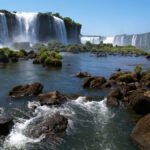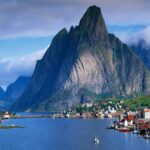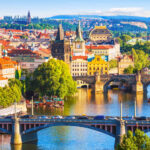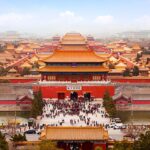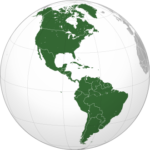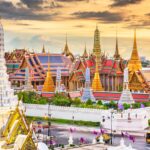
Kyiv is the capital and most populous city of Ukraine. It is in north-central Ukraine along the Dnieper River. As of 1 January 2021, its population was 2,962,180, making Kyiv the seventh-most populous city in Europe. Kyiv is an important industrial, scientific, educational, and cultural center in Eastern Europe. It is home to many high-tech industries, higher education institutions, and historical landmarks. The city has an extensive system of public transport and infrastructure, including the Kyiv Metro.. (Source from Wikipedia)
Editor’s message – THE brave people of Ukraine are in the thoughts and hearts of the world. Give comfort to those who suffer because of the Ukraine – Russia WAR. Give comfort to those who mourn their dead, and strength to neighboring countries to welcome the refugees. Convert the hearts of those who resort to arms and protect those who work to promote peace.



1. Kiev Pechersk Lavra
Kyiv-Pechersk Lavra also known as the Kiev Monastery of the Caves, is a historic Eastern Orthodox Christian monastery which gave its name to one of the city districts where it is located in Kyiv. Since its foundation as the cave monastery in 1051, the Lavra has been a preeminent center of Eastern Orthodox Christianity in Eastern Europe. Together with the Saint Sophia Cathedral, it is inscribed as a UNESCO World Heritage Site. The monastery complex is considered a separate national historic-cultural preserve , the national status to which was granted on 13 March 1996. The Lavra is not only located in another part of the city, but is part of a different national sanctuary than Saint Sophia Cathedral. While being a cultural attraction, the monastery is once again active, with over 100 monks in residence.[citation needed] It was named one of the Seven Wonders of Ukraine on 21 August 2007.
![kyiv-one-of-the-most-beautiful-cities-in-the-world3jpg-1200x537[1]](https://hobbymart.net/wp-content/uploads/2022/05/kyiv-one-of-the-most-beautiful-cities-in-the-world3jpg-1200x5371-1-768x344.jpg)
![kiev-lavra-min[1]](https://hobbymart.net/wp-content/uploads/2022/05/kiev-lavra-min1-768x316.jpg)
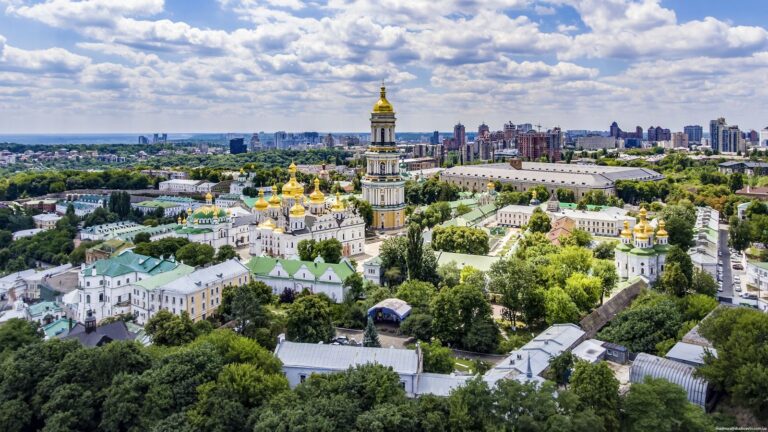
![1[1]](https://hobbymart.net/wp-content/uploads/2022/05/11-3-768x433.jpg)
2. Great Lavra Bell Tower
The Great Lavra Bell Tower or the Great Belfry is the main bell tower of the ancient cave monastery of Kyiv Pechersk Lavra in Kyiv, the capital of Ukraine. It is one of the most notable buildings of the Kyiv skyline. The bell tower was the highest free-standing bell tower at the time of its construction in 1731–1745. It was designed by the architect Johann Gottfried Schädel. Its total height, with the Christian cross, is 96.5 metres (316 feet). The Great Lavra Bell Tower is a Neoclassical architecture construction with a total of four tiers, surmounted by a gilded dome. The diameter of the tower's lowest tier at its base is 28.8 metres (94 feet), and the thickness of the first tier walls is 8 metres (26 feet). The tower's foundation exceeds 7 metres (22 feet). The tower is decorated with many architectural columns: the second tier is decorated with 32 Dorian columns, the third tier is decorated with 16 Ionic columns, and the fourth with 8 Corinthian columns.

3. Saint Sophia’s Cathedral
Saint Sophia Cathedral in Kyiv, Ukraine, is an architectural monument of Kyivan Rus. The former cathedral is one of the city's best known landmarks and the first heritage site in Ukraine to be inscribed on the World Heritage List along with the Kyiv Cave Monastery complex. Aside from its main building, the cathedral includes an ensemble of supporting structures such as a bell tower and the House of Metropolitan. In 2011 the historic site was reassigned from the jurisdiction of the Ministry of Regional Development of Ukraine to the Ministry of Culture of Ukraine. One of the reasons for the move was that both Saint Sophia Cathedral and Kyiv Pechersk Lavra are recognized by the UNESCO World Heritage Program as one complex, while in Ukraine the two were governed by different government entities. It is currently a museum.
4. Pirogovo – Kiev Museum of Folk Architecture and Life
Pyrohiv also known as Pirogov, originally a village south of Kyiv, is a neighborhood in the southern outskirts of the Ukrainian capital city. It is now home to an outdoor Museum of Folk Architecture and Life of Ukraine. Although the origin of the toponym is uncertain, pyrohiv is genitive plural form of the Ukrainian word for pie.
5. St Michael’s Golden-Domed Monastery
St. Michael's Golden-Domed Monastery is a monastery in Kyiv, the capital of Ukraine. The monastery is located on the edge of the bank of the Dnieper River, northeast of the Saint Sophia Cathedral. The site is located in the historic administrative Uppertown and overlooks the city's historical commercial and merchant quarter, the Podil neighbourhood.

6. The Motherland Monument
The Motherland Monument is a monumental statue in Kyiv, the capital of Ukraine. The sculpture is a part of the National Museum of the History of Ukraine in the Second World War. The stainless steel statue stands 62 m (203 ft) tall upon the museum main building with the overall structure measuring 102 m (335 ft) including its base and weighing 560 tonnes. The sword in the statue's right hand is 16 m (52 ft) long weighing 9 tonnes, with the left hand holding up a 13 by 8 m (43 by 26 ft) shield emblazoned with the hammer and sickle emblem of the Soviet Union.
![preview-342893-Mn6i3G22DozstcNC-large[1]](https://hobbymart.net/wp-content/uploads/2022/05/preview-342893-Mn6i3G22DozstcNC-large1-768x432.jpg)
![image-1[1]](https://hobbymart.net/wp-content/uploads/2022/05/image-11-768x432.jpg)
![206939[1]](https://hobbymart.net/wp-content/uploads/2022/05/2069391-768x432.jpg)


7. Museum of the History of Ukraine in World War II
The National Museum of the History of Ukraine in the Second World War is a memorial complex commemorating the German-Soviet War located in the southern outskirts of the Pechersk district of Kyiv, the capital of Ukraine, on the picturesque hills on the right-bank of the Dnipro River.

8. Maidan Nezalezhnosti
Maidan Nezalezhnosti is the central square of Kyiv, the capital city of Ukraine. One of the city's main squares, it is located on Khreshchatyk Street in the Shevchenko Raion. The square has been known under many different names, but often it is called by people simply Maidan.

9. Khreshchatyk
Khreshchatyk is the main street of Kyiv, Ukraine. The street has a length of 1.2 kilometres (0.75 mi). It stretches from the European Square (northeast) through the Maidan and to Bessarabska Square (southwest) where the Besarabsky Market is located. Along the street are the offices of the Kyiv City Council which contains both the city's council and the state administration, the Main Post Office, the Ministry of Agrarian Policy, the State Committee of Television and Radio Broadcasting, the Central Department Store (TsUM), the Ukrainian House, and others.
10. Andriyivskyy Descent
Andriyivskyy Descent is a historic descent connecting Kyiv's Upper Town neighborhood and the historically commercial Podil neighborhood. The street, often advertised by tour guides and operators as the "Montmartre of Kyiv", is a major tourist attraction of the city. It is included in the list of national landmarks by the government resolution.[4][b] In addition, the street is also part of the Kyiv city historic reserve "Ancient Kyiv", while the St.Andrew's Church belongs to the National historic reserve "Sophia of Kyiv".

11. Podil
Podil or Podol is a historic neighborhood in Kyiv, the capital of Ukraine. It is located on a floodplain terrace over the Dnieper between the Kyiv Hills and the lower stream of Pochaina River. Podil is one of the oldest neighborhoods of Kyiv, and the birthplace of the city's trade, commerce and industry. After the Mongol invasion of Rus' and destruction of Kyiv, it served as a city center until the 19th century. Here the city administration (magistrate) and the main university were located, and later the city's port and shipyard were established here. Podil contains many architectural and historical landmarks, and new archaeological sites are still being revealed. It is a part of the city's larger administrative Podilskyi District.

12. St Volodymyr’s Cathedral
St Volodymyr's Cathedral is a cathedral in the centre of Kyiv. It is one of the city's major landmarks and the mother cathedral of the Ukrainian Orthodox Church – Kyiv Patriarchate, one of two major Ukrainian Orthodox Churches. The architecture is 19th-century Neo-Byzantine, and many of the frescoes were painted by the feted Russian Romantic Nationalist Viktor Vasnetsov.

13. Mykola Syadristy Microminiature Museum
Mykola Syadristy Microminiature Museum Truly amazing microminiature compositions placed on pin heads, seeds, human hair and other tiny platforms. Ukrainian Mykola Syadristy is the genius behind the art of microminiature objects that are so small they can only be viewed through a microscope.
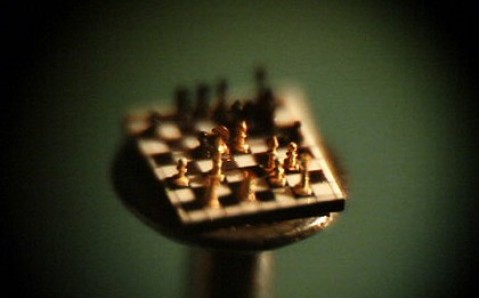
![Mykola-Syadristys-Microminiatures-Museum-unusual-museums-in-Ukraine-Kiev-tour-guide[1]](https://hobbymart.net/wp-content/uploads/2022/05/Mykola-Syadristys-Microminiatures-Museum-unusual-museums-in-Ukraine-Kiev-tour-guide1-768x500.jpg)
![Mykola-Syadristy-Microminiature-Museum[1]](https://hobbymart.net/wp-content/uploads/2022/05/Mykola-Syadristy-Microminiature-Museum1.jpg)
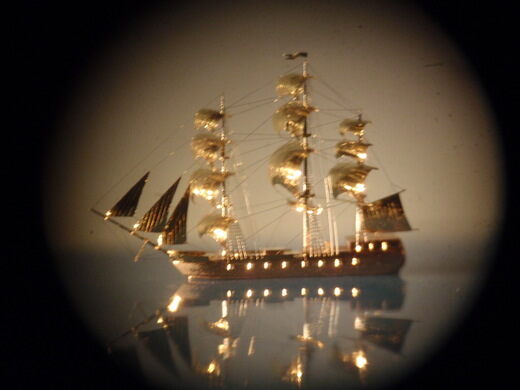

14. Mikhail Bulgakov Museum
Mikhail Bulgakov Museum (officially known as Literature-Memorial Museum to Mikhail Bulgakov, commonly called the Bulgakov House or Lystovnychyi House) is a museum in Kyiv, Ukraine, dedicated to Kyiv-born Russian writer Mikhail Bulgakov. Commenced in February 1989, and opened on May 15, 1991 for the 100th anniversary of the writer's birth, the museum is located at №13 on the Andriyivskyy Descent and contains an exposition of nearly 2500 pieces that include Bulgakov's belongings, books, postcards, and photos – conveying the life and creativity of the writer and his surroundings. The atmosphere of the house reflects the writer's life – as a secondary school pupil, student of medicine, family doctor, and writer—when Bulgakov wrote The White Guard, The Master and Margarita, and Theatre Love Story.

15. Hryshko National Botanical Garden
The M. M. Hryshko National Botanical Garden is a botanical garden of the National Academy of Sciences of Ukraine. It is named after the Soviet botanist Mykola Hryshko who was born in Poltava. Founded in 1936, the garden covers 1.3 km² (120 hectares) and contains 13,000 types of trees, shrubs, flowers and other plants from all over the world. It has many coniferous trees and honey locusts, and flowers such as peonies, roses, magnolias, and bushes including lilacs. The garden has hothouses, conservatories, greenhouses and rosaries. It is the most popular amongst the residents, where one can see exotic plants, and attend flower exhibitions. The blooming lilacs at the end of spring are popular in the central garden. The Vydubychi Monastery and Trinity Monastery of St. Jonas are located on the grounds of the botanical gardens.

16. State Aviation Museum
The State Aviation Museum is an aviation museum located next to Zhulyany Airport in Kyiv, Ukraine. The museum offers both aircraft exhibits and interactive displays. The museum is one of the larger aviation museums displaying Soviet technology.[1] The museum opened its doors to the public on 30 September 2003, with Yuriy Ziatdinov as curator. Both the premises and the planes are provided by the National Aviation University which continues to use some of the exhibits as educational props on site.
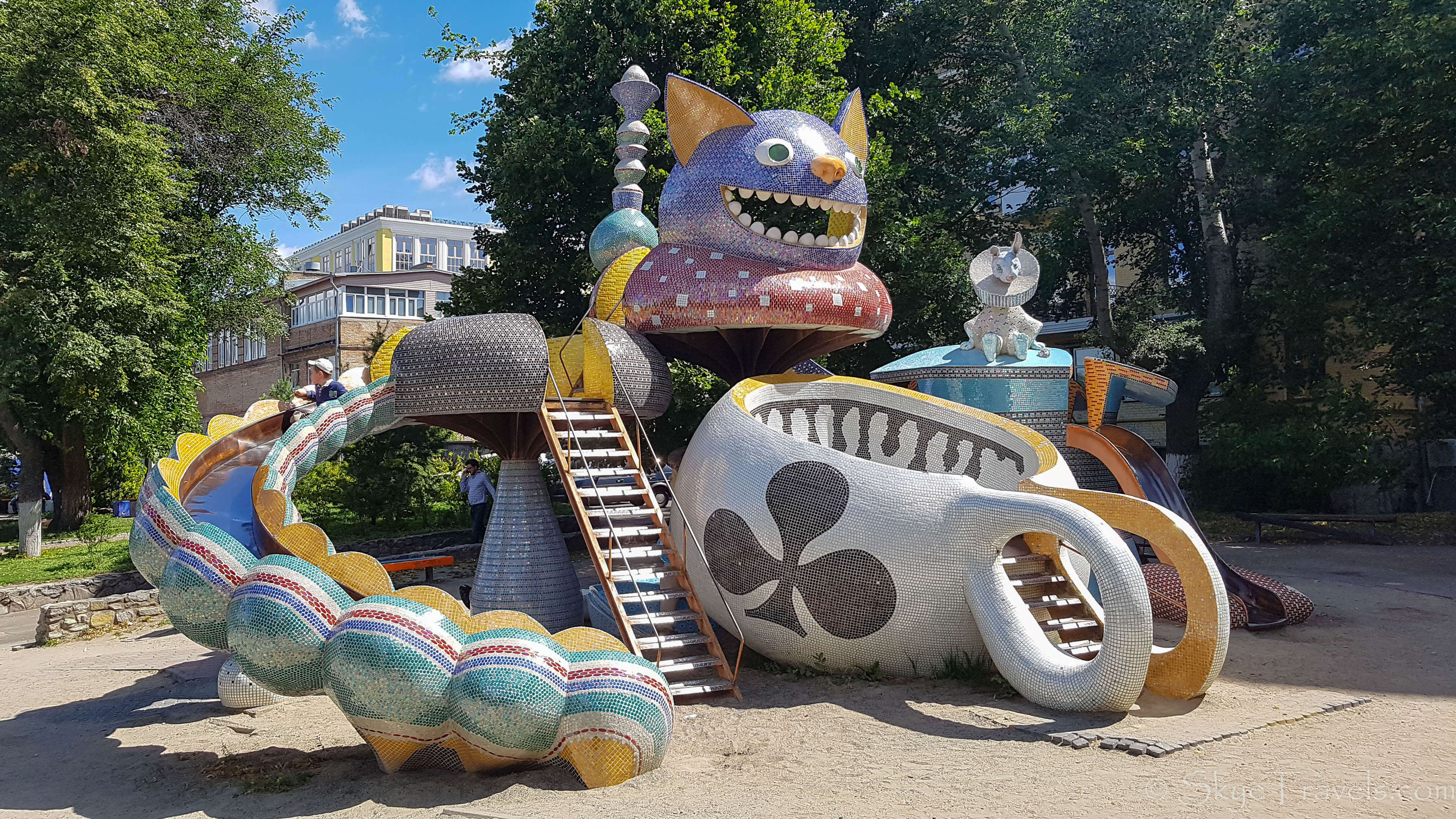
17. Landscape Alley
On the south side of the Andriyivskyy Descent, just off Velyka Zhytomyrska Street is a green space that has been turned into a wonderland by dozens of pieces of public art. If there’s one thing all the artworks have in common it’s that they’re whimsical, light-hearted and adored by kids. Some of the characters you’ll meet are a 30-metre cat centipede, a happy elephant fountain and benches in the form of a crow, cat and rabbit, all covered with mosaic tiles. And at this hillside setting you can bask in photogenic views of Podil, the Dnieper River and Zamkova Hora (Castle Hill).

18. One Street Museum
On the south side of the Andriyivskyy Descent, just off Velyka Zhytomyrska Street is a green space that has been turned into a wonderland by dozens of pieces of public art. If there’s one thing all the artworks have in common it’s that they’re whimsical, light-hearted and adored by kids. Some of the characters you’ll meet are a 30-metre cat centipede, a happy elephant fountain and benches in the form of a crow, cat and rabbit, all covered with mosaic tiles. And at this hillside setting you can bask in photogenic views of Podil, the Dnieper River and Zamkova Hora (Castle Hill).
19. Golden Gate
The Golden Gate of Kyiv was the main gate in the 11th century fortifications of Kiev (today Kyiv), the capital of Kievan Rus'. It was named in imitation of the Golden Gate of Constantinople. The structure was dismantled in the Middle Ages, leaving few vestiges of its existence. It was rebuilt completely by the Soviet authorities in 1982, though no images of the original gates have survived. The decision has been immensely controversial because there were many competing reconstructions of what the original gate might have looked like.

20. National Opera House
The Kyiv Opera group was formally established in the summer of 1867, and is the third oldest in Ukraine, after Odessa Opera and Lviv Opera. The Kyiv Opera Company perform at the National Opera House of Ukraine named after Taras Shevchenko in Kyiv. The Opera in 2 acts, Natalka Poltavka, was the last scheduled performance before the 2022 Russian invasion of Ukraine.
21. St Cyril’s Monastery
St. Cyril's Monastery is a medieval monastery in Kyiv, the capital of Ukraine. The monastery contains the famous St. Cyril's Church, an important specimen of Kyivan Rus architecture of the 12th century, and combining elements of the 17th and 19th centuries. However, being largely Ukrainian Baroque on the outside, the church retains its original Kyivan Rus interior.

22. Babi Yar
Babi Yar or Babyn Yar is a ravine in the Ukrainian capital Kyiv and a site of massacres carried out by Nazi Germany's forces during its campaign against the Soviet Union in World War II. The first and best documented of the massacres took place on 29–30 September 1941, killing some 33,771 Jews. The decision to murder all the Jews in Kyiv was made by the military governor Generalmajor Kurt Eberhard, the Police Commander for Army Group South, SS-Obergruppenführer Friedrich Jeckeln, and the Einsatzgruppe C Commander Otto Rasch. Sonderkommando 4a as the sub-unit of Einsatzgruppe C, along with the aid of the SD and Order Police battalions with the Ukrainian Auxiliary Police backed by the Wehrmacht, carried out the orders. Sonderkommando 4a and the 45th Battalion of the German Order Police conducted the shootings. Servicemen of the 303rd Battalion of the German Order Police at this time guarded the outer perimeter of the execution site.

23. Taras Shevchenko Park
One of the prettiest parks is Taras Shevchenko Park, fronting the Taras Shevchenko National University and a popular hangout for students. But they’re not the only ones who meet-up here, as older citizens gather for boisterous games of chess that can get very heated. Little ones can take pony rides, and you can also see the statue of Taras Shevchenko surrounded by flowerbeds. This 19th-century writer and polymath has had an enormous influence on Ukrainian culture and helped to shape the modern Ukrainian language.

24. House with Chimeras
House with Chimaeras or Horodecki House is an Art Nouveau building located in the historic Lypky neighborhood of Kyiv, the capital of Ukraine. Situated across the street from the President of Ukraine's office at No. 10, Bankova Street, the building has been used as a presidential residence for official and diplomatic ceremonies since 2005. The street in front of the building is closed off to all automobile traffic, and is now a patrolled pedestrian zone due to its near proximity to the Presidential Administration building.

25. Besarabsky Market
The Besarabsky Market is an indoor market located in the center of Kyiv on the Bessarabska Square at the southwest end of the city's main thoroughfare, the Khreshchatyk. Constructed in 1910-1912 to a design of Polish architect Henryk Julian Gay, the market features 896 square metres (9,640 sq ft) of market space.


